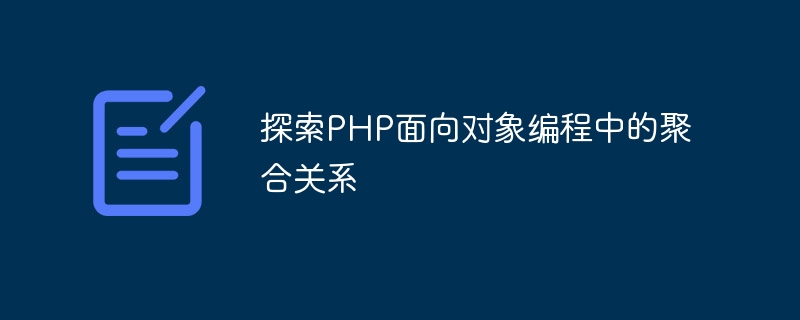

Explore the aggregation relationship in PHP object-oriented programming
In object-oriented programming, the aggregation relationship is a way to represent the relationship between objects. In PHP, using aggregation relationships can effectively organize and manage dependencies between objects, improving code reusability and maintainability. This article will explore aggregation relationships in PHP object-oriented programming and provide relevant code examples.
Aggregation relationship is a strong association relationship, which means that one object contains other objects, and these objects can exist independently. In an aggregation relationship, the contained objects are called aggregate objects, and the objects that contain other objects are called aggregate objects. Aggregation relationships can be used to represent the relationship between the whole and parts, such as the relationship between a class and multiple students, the relationship between an order and multiple products, etc.
In PHP, a common way to implement an aggregation relationship is by using one object as a property of another object. For example, we can have a class class (Classroom) that contains multiple student objects (Student). The following is a simple code example:
class Student { private $name; public function __construct($name) { $this->name = $name; } public function getName() { return $this->name; } } class Classroom { private $students = array(); public function addStudent(Student $student) { $this->students[] = $student; } public function getStudents() { return $this->students; } } // 创建学生对象 $student1 = new Student('张三'); $student2 = new Student('李四'); $student3 = new Student('王五'); // 创建班级对象 $classroom = new Classroom(); // 添加学生到班级中 $classroom->addStudent($student1); $classroom->addStudent($student2); $classroom->addStudent($student3); // 获取班级中的学生列表 $students = $classroom->getStudents(); // 输出学生列表 foreach ($students as $student) { echo $student->getName() . PHP_EOL; }
In the above example, we first define a student class (Student), which has a private property $name and a public method getName() for obtaining students name. Then we defined a class class (Classroom), which has a private property $students for storing an array of student objects, a public method addStudent() for adding student objects to the class, and a public method getStudents() for Returns the list of students in the class. We create several student objects and add them to the class object. Finally, we get the student list by calling the getStudents() method and output the students' names in sequence.
Through aggregation relationships, we can easily manage dependencies between objects. For example, in the above example, a class object can contain multiple student objects, and these student objects can exist independently. Such a design can improve the flexibility and scalability of the code, and aggregate objects can be easily added, deleted, or manipulated in subsequent operations.
In summary, the aggregation relationship in PHP object-oriented programming is a way to represent the relationship between objects, by treating one object as a property of another object. Through aggregation relationships, we can easily organize and manage dependencies between objects and improve code reusability and maintainability. In practical applications, we can design and use aggregation relationships according to specific needs, making the code clearer, readable, and easier to maintain.
The above is the detailed content of Explore Aggregation Relationships in PHP Object-Oriented Programming. For more information, please follow other related articles on the PHP Chinese website!




